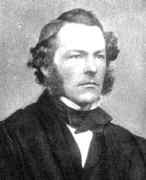Person: Stokes, George Gabriel

George Stokes established the science of hydrodynamics with his law of viscosity describing the velocity of a small sphere through a viscous fluid.
Mathematical Profile (Excerpt):
- In particular, having studied at Trinity College Dublin, he was able to teach George Latin grammar.
- Leaving Skreen in 1832, George attended school in Dublin.
- In 1835, at the age of 16, George Stokes moved to England and entered Bristol College in Bristol.
- The two years which Stokes spent in Bristol at this College were important ones in preparing him for his studies at Cambridge.
- It was not Trinity, rather Pembroke College, Cambridge, which Stokes entered in 1837.
- In Stokes' second year at Cambridge he began to be coached by William Hopkins, a famous Cambridge coach who played a more important role than the lecturers.
- Hopkins was to exert a strong influence on the direction of Stokes' mathematical interests.
- In 1841 Stokes graduated as Senior Wrangler (the top First Class degree) in the Mathematical Tripos and he was the first Smith's prizeman.
- It was William Hopkins who advised Stokes to undertake research into hydrodynamics and indeed this was the area in which Stokes began to work.
- In addition to Hopkins's advice, Stokes was also inspired to enter this field by the recent work of George Green.
- Stokes published papers on the motion of incompressible fluids in 1842 and 1843, in particular On the steady motion of incompressible fluids in 1842.
- After completing this research Stokes discovered that Duhamel had already obtained similar results but, since Duhamel had been working on the distribution of heat in solids, Stokes decided that his results were obtained in a sufficiently different situation to justify him publishing.
- Stokes then continued his investigations, looking at the situation where he took into account internal friction in fluids in motion.
- After he had deduced the correct equations of motion Stokes discovered that again he was not the first to obtain the equations since Navier, Poisson and Saint-Venant had already considered the problem.
- Again Stokes decided that his results were obtained with sufficiently different assumptions to justify publication and he published On the theories of the internal friction of fluids in motion in 1845.
- The work also discussed the equilibrium and motion of elastic solids and Stokes used a continuity argument to justify the same equation of motion for elastic solids as for viscous fluids.
- Perhaps the most important event in the recognition of Stokes as a leading mathematician was his Report on recent researches in hydrodynamics presented to the British Association for the Advancement of Science in 1846.
- In 1845 Stokes had published an important work on the aberration of light, the first of a number of important works on this topic.
- In 1849 Stokes was appointed Lucasian Professor of Mathematics at Cambridge.
- The Lucasian chair paid very poorly so Stokes needed to earn additional money and he did this by accepting an additional position to the Lucasian chair, namely that of Professor of Physics at the Government School of Mines in London.
- Stokes' work on the motion of pendulums in fluids led to a fundamental paper on hydrodynamics in 1851 when he published his law of viscosity, describing the velocity of a small sphere through a viscous fluid.
- Stokes's methods for solving diffraction problems, differing considerably from the methods employed by Cauchy, form the basis of the further studies of the mathematical theory of the phenomenon of diffraction.
- Stokes named and explained the phenomenon of fluorescence in 1852.
- In 1854 Stokes theorised an explanation of the Fraunhofer lines in the solar spectrum.
- However when Kirchhoff later published this explanation, Stokes disclaimed any prior discovery.
- Stokes' career certainly took a rather different tack in 1857 when he moved from his highly active theoretical research period into one where he became more involved with administration and experimental work.
- Certainly his marriage in 1857 was not unconnected with the change in tack and, particularly since it gives us an insight into Stokes' personality, we shall look at the events.
- The marriage did go ahead and Stokes certainly turned away from his life of intense mathematical research.
- It may appear from the above quotations that in fact Stokes was really looking for this change in his life and perhaps he sought marriage partly so that this change in his life-style could come about.
- Stokes continued as secretary of the Royal Society from his appointment in 1854 until 1885 when he was elected President of the Society.
- Stokes received the Copley medal from the Royal Society in 1893 and he was given the highest possible honour by his College when he served as Master of Pembroke College in 1902-3.
- Stokes was a very important formative influence on subsequent generations of Cambridge men, including Maxwell.
- With Green, who in turn had influenced him, Stokes followed the work of the French, especially Lagrange, Laplace, Fourier, Poisson, and Cauchy.
- This is seen most clearly in his theoretical studies in optics and hydrodynamics; but it should also be noted that Stokes, even as an undergraduate, experimented incessantly.
- Stokes' mathematical and physical papers were published in five volumes, the first three of which Stokes edited himself in 1880, 1883 and 1891.
Born 13 August 1819, Skreen, County Sligo, Ireland. Died 1 February 1903, Cambridge, England.
View full biography at MacTutor
Tags relevant for this person:
Origin Ireland, Physics
Thank you to the contributors under CC BY-SA 4.0! 

- Github:
-

- non-Github:
- @J-J-O'Connor
- @E-F-Robertson
References
Adapted from other CC BY-SA 4.0 Sources:
- O’Connor, John J; Robertson, Edmund F: MacTutor History of Mathematics Archive
